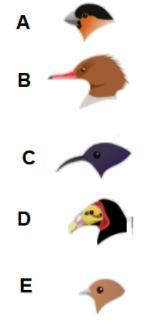
Answer
366.9k+ views
Hint: Beak of the bird is the external anatomy of the birds and also seen in several mammals. The beak is used for feeding, killing prey, fighting, courtship, eating, manipulating object and also making nests. The beaks of the birds differ widely depending on the food and the habitat they live in. The birds that suck nectar should have long beak so that they can go deep inside the flower.
Complete answer:
To answer this question, we must know about the different types of beaks in birds. The beaks or the birds differ in shape, size, colour and texture but the basic structure is similar. The beaks have two bony projections called the upper and the lower mandible. It is covered by a thin layer of keratin which forms the epidermis. The nares or two holes are present which serve for respiratory functions.
Let us discuss the given types of beaks given in the question.
Figure A represents the beak of grain-eating birds that have conical beaks. They have strong upper and lower mandibles. This structure helps in breaking the shells of seeds and grains. Example sparrow.
Figure B represents the beak that is involved in fishing. The beaks of these birds like herons, the crane is long, strong and are pointed and looks like a dagger. They have serrated beak edges which help in catching prey.
Figure C represents the beak of nectar probing birds. The beaks of nectar sucking birds are long slender and pointed. This helps in sucking nectar and also feeding insects and food to the young ones. An example of such birds is the hummingbirds.
Figure D represents the beak of scavenging birds like eagles. These birds have strong and hook-like beaks which have an upper part that protrudes over the lower part. They are used to tear, pull the flesh of the prey.
Figure E represents the beak of insect catching birds. These beaks are curved and sharp so as to enter any surface in search of insects. An example of such birds is the bluebirds.
Thus the correct answer is option ‘C’.
Note: The concentration of pigments like melanin and carotenoids determine the colour of the beak. The Eumelanin is present in the bare parts which give grey-black colour. The pigment is concentrated on the epidermis.
Complete answer:
To answer this question, we must know about the different types of beaks in birds. The beaks or the birds differ in shape, size, colour and texture but the basic structure is similar. The beaks have two bony projections called the upper and the lower mandible. It is covered by a thin layer of keratin which forms the epidermis. The nares or two holes are present which serve for respiratory functions.
Let us discuss the given types of beaks given in the question.
Figure A represents the beak of grain-eating birds that have conical beaks. They have strong upper and lower mandibles. This structure helps in breaking the shells of seeds and grains. Example sparrow.
Figure B represents the beak that is involved in fishing. The beaks of these birds like herons, the crane is long, strong and are pointed and looks like a dagger. They have serrated beak edges which help in catching prey.
Figure C represents the beak of nectar probing birds. The beaks of nectar sucking birds are long slender and pointed. This helps in sucking nectar and also feeding insects and food to the young ones. An example of such birds is the hummingbirds.
Figure D represents the beak of scavenging birds like eagles. These birds have strong and hook-like beaks which have an upper part that protrudes over the lower part. They are used to tear, pull the flesh of the prey.
Figure E represents the beak of insect catching birds. These beaks are curved and sharp so as to enter any surface in search of insects. An example of such birds is the bluebirds.
Thus the correct answer is option ‘C’.
Note: The concentration of pigments like melanin and carotenoids determine the colour of the beak. The Eumelanin is present in the bare parts which give grey-black colour. The pigment is concentrated on the epidermis.
Recently Updated Pages
How many sigma and pi bonds are present in HCequiv class 11 chemistry CBSE

Mark and label the given geoinformation on the outline class 11 social science CBSE

When people say No pun intended what does that mea class 8 english CBSE

Name the states which share their boundary with Indias class 9 social science CBSE

Give an account of the Northern Plains of India class 9 social science CBSE

Change the following sentences into negative and interrogative class 10 english CBSE

Trending doubts
Which are the Top 10 Largest Countries of the World?

Difference between Prokaryotic cell and Eukaryotic class 11 biology CBSE

Why is October 161905 regarded as an important day class 10 social science CBSE

Fill the blanks with the suitable prepositions 1 The class 9 english CBSE

Which river is known as Ganga of the south A Krishna class 11 social science CBSE

Give 10 examples for herbs , shrubs , climbers , creepers

Difference Between Plant Cell and Animal Cell

Differentiate between homogeneous and heterogeneous class 12 chemistry CBSE

Change the following sentences into negative and interrogative class 10 english CBSE




